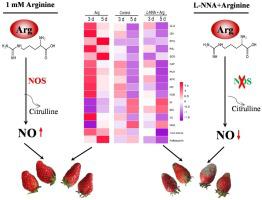当前位置:
X-MOL 学术
›
Postharvest Biol. Technol.
›
论文详情
Our official English website, www.x-mol.net, welcomes your
feedback! (Note: you will need to create a separate account there.)
L-Arginine treatment attenuates postharvest decay and maintains quality of strawberry fruit by promoting nitric oxide synthase pathway
Postharvest Biology and Technology ( IF 6.4 ) Pub Date : 2020-10-01 , DOI: 10.1016/j.postharvbio.2020.111253 Pan Shu , Dedong Min , Wen Ai , Jiaozhuo Li , Jingxiang Zhou , Zilong Li , Xinhua Zhang , Zedong Shi , Yingjie Sun , Yaping Jiang , Fujun Li , Xiaoan Li , Yanyin Guo
Postharvest Biology and Technology ( IF 6.4 ) Pub Date : 2020-10-01 , DOI: 10.1016/j.postharvbio.2020.111253 Pan Shu , Dedong Min , Wen Ai , Jiaozhuo Li , Jingxiang Zhou , Zilong Li , Xinhua Zhang , Zedong Shi , Yingjie Sun , Yaping Jiang , Fujun Li , Xiaoan Li , Yanyin Guo

|
Abstract In this study, the impacts of Arginine (Arg) on strawberry fruit quality and postharvest decay caused by fungi, as well as on the nitric oxide synthase (NOS) pathway of strawberry fruit, were considered. Strawberry fruits were first treated with 0, 0.5, 1, 5, and 10 mM Arg solution, and the result showed that treatment with 1 mM Arg was the best in inhibiting fruit decay and maintaining fruit quality, which is indicated by firmness, titratable acid, soluble solid content and respiration rate. To investigate the action mechanism of Arg and determine whether NOS is involved in the process, strawberry fruits were further treated with 1 mM Arg and 0.2 mM Nω-nitro-L-arginine (L-NNA), a specific inhibitor of NOS, before storage at 20 ± 1 °C. In addition to reducing the decay incidence (DIC) and the decay index (DI), 1 mM Arg triggered NO accumulation, resulting from higher NOS activity, which is associated with a higher vitamin C, anthocyanin and total phenolic content, as well as the activities of the antioxidant enzymes - superoxide dismutase (SOD), catalase (CAT), peroxidase (POD) and ascorbate peroxidase (APX) - which are associated with a lower malondialdehyde (MDA) content. Moreover, the expression level of the pathogenesis-related protein1 (FaPR1) and the activities of the defense enzymes - phenylalanine ammonialyase (PAL), chitinase (CHI), β-1,3-glucanase (GLU) and polyphenol oxidase (PPO) – were higher in the Arg-treated fruits. However, such effects of 1 mM Arg treatment on strawberry fruits were almost reversed by the simultaneous addition of 0.2 mM L-NNA, leading to severer fruit decay. In addition, correlation analysis showed that Arg treatment significantly improved the correlation of NO with the activities of GLU (R2 = 0.72*), CHI (R2 = 0.85**), PAL (R2 = 0.67*) and APX (R2 = 0.72*). These findings indicated that Arg treatment might be a useful technique to improve quality and delay postharvest decay in strawberry fruit, and the NOS pathway played an important role in this process.
中文翻译:

L-精氨酸处理通过促进一氧化氮合酶途径减轻采后腐烂并保持草莓果实品质
摘要 本研究考虑了精氨酸(Arg)对草莓果实品质、真菌引起的采后腐烂以及草莓果实一氧化氮合酶(NOS)途径的影响。草莓果实首先用0、0.5、1、5和10 mM Arg溶液处理,结果表明1 mM Arg处理对抑制果实腐烂和保持果实品质的效果最好,表现为硬度、可滴定酸、可溶性固形物含量和呼吸速率。为了研究 Arg 的作用机制并确定 NOS 是否参与该过程,草莓果实在储存前用 1 mM Arg 和 0.2 mM Nω-硝基-L-精氨酸 (L-NNA)(一种 NOS 特异性抑制剂)进一步处理在 20 ± 1 °C。除了降低衰减发生率 (DIC) 和衰减指数 (DI),1 mM Arg 引发 NO 积累,这是由于更高的 NOS 活性导致的,这与更高的维生素 C、花青素和总酚含量以及抗氧化酶 - 超氧化物歧化酶 (SOD)、过氧化氢酶 (CAT)、过氧化物酶的活性有关(POD) 和抗坏血酸过氧化物酶 (APX) - 它们与较低的丙二醛 (MDA) 含量有关。此外,发病相关蛋白 1 (FaPR1) 的表达水平和防御酶的活性 - 苯丙氨酸解氨酶 (PAL)、几丁质酶 (CHI)、β-1,3-葡聚糖酶 (GLU) 和多酚氧化酶 (PPO) –在 Arg 处理的水果中更高。然而,1 mM Arg 处理对草莓果实的这种影响几乎被同时添加 0.2 mM L-NNA 所逆转,导致更严重的果实腐烂。此外,相关性分析表明,Arg处理显着提高了NO与GLU(R2=0.72*)、CHI(R2=0.85**)、PAL(R2=0.67*)和APX(R2=0.72*)活性的相关性。这些发现表明 Arg 处理可能是提高草莓果实品质和延缓采后腐烂的有用技术,并且 NOS 途径在该过程中发挥了重要作用。
更新日期:2020-10-01
中文翻译:

L-精氨酸处理通过促进一氧化氮合酶途径减轻采后腐烂并保持草莓果实品质
摘要 本研究考虑了精氨酸(Arg)对草莓果实品质、真菌引起的采后腐烂以及草莓果实一氧化氮合酶(NOS)途径的影响。草莓果实首先用0、0.5、1、5和10 mM Arg溶液处理,结果表明1 mM Arg处理对抑制果实腐烂和保持果实品质的效果最好,表现为硬度、可滴定酸、可溶性固形物含量和呼吸速率。为了研究 Arg 的作用机制并确定 NOS 是否参与该过程,草莓果实在储存前用 1 mM Arg 和 0.2 mM Nω-硝基-L-精氨酸 (L-NNA)(一种 NOS 特异性抑制剂)进一步处理在 20 ± 1 °C。除了降低衰减发生率 (DIC) 和衰减指数 (DI),1 mM Arg 引发 NO 积累,这是由于更高的 NOS 活性导致的,这与更高的维生素 C、花青素和总酚含量以及抗氧化酶 - 超氧化物歧化酶 (SOD)、过氧化氢酶 (CAT)、过氧化物酶的活性有关(POD) 和抗坏血酸过氧化物酶 (APX) - 它们与较低的丙二醛 (MDA) 含量有关。此外,发病相关蛋白 1 (FaPR1) 的表达水平和防御酶的活性 - 苯丙氨酸解氨酶 (PAL)、几丁质酶 (CHI)、β-1,3-葡聚糖酶 (GLU) 和多酚氧化酶 (PPO) –在 Arg 处理的水果中更高。然而,1 mM Arg 处理对草莓果实的这种影响几乎被同时添加 0.2 mM L-NNA 所逆转,导致更严重的果实腐烂。此外,相关性分析表明,Arg处理显着提高了NO与GLU(R2=0.72*)、CHI(R2=0.85**)、PAL(R2=0.67*)和APX(R2=0.72*)活性的相关性。这些发现表明 Arg 处理可能是提高草莓果实品质和延缓采后腐烂的有用技术,并且 NOS 途径在该过程中发挥了重要作用。











































 京公网安备 11010802027423号
京公网安备 11010802027423号